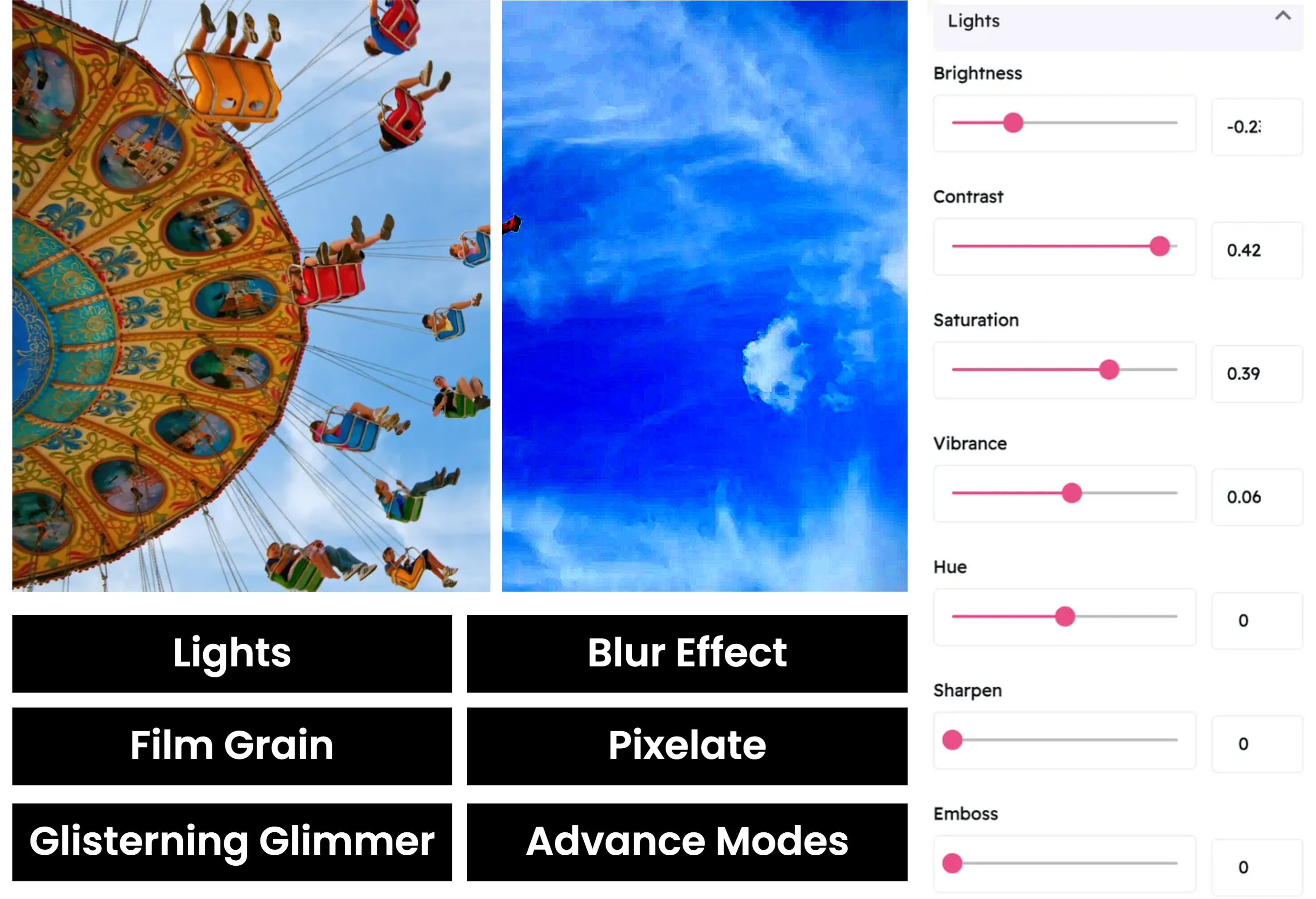Film Grain: Add Texture and Character to Your Images
Create Authentic Vintage and Cinematic Looks
Snapied Film Grain Effect gives you the power to add authentic film-like texture to your digital images. Create vintage aesthetics, cinematic moods, or add subtle texture to flat digital photos with precise control over noise intensity.
Unlike basic noise filters, our film grain tool offers fine-tuned control with a range from 0 to 1000, allowing you to create subtle film-like textures or dramatic grainy effects. Perfect for photography, social media posts, and creating professional-looking designs with character and depth.

Apply Film Grain in Four Simple Steps
Add authentic film texture to your images with our intuitive grain tool:
Upload Your Image
Start by uploading the image you want to enhance. Snapied supports all major image formats including JPG, PNG, WebP, and more.
Access Adjustment Panel
Select your image and click on the Adjustments icon in the left sidebar. This will open the comprehensive adjustment panel.
Open Film Grain Control
In the Adjustments panel, locate and click on the "Lights" section to expand the lighting controls. Find and expand the "Film Grain" option to access the noise intensity slider.
Adjust and Apply
Use the intuitive noise slider to set the intensity of the film grain effect. Move the slider to the right to increase grain and create a more textured look. Each change is previewed in real-time, allowing you to see exactly how your modifications affect the image. Once you're satisfied with the results, click "Apply" to finalize your changes.
Interactive Film Grain Control
Experience our intuitive noise slider that gives you precise control over your image's film grain texture

Film Grain Effect Examples
See how different noise settings can transform your images

Subtle Film Grain
A light grain effect adds a gentle texture without overwhelming the image. Perfect for adding a touch of character to digital photos while maintaining image clarity.

Medium Film Grain
A moderate grain creates a more noticeable film-like texture that's ideal for vintage photography styles and creating a cinematic mood in your images.

Strong Film Grain
A significant grain effect creates a dramatic textured look perfect for high-contrast black and white photography, gritty aesthetics, or creating a heavily stylized film appearance.
Before & After: See the Difference
Examine the impact of film grain on image texture and mood

Before Film Grain
Original digital image with smooth, clean surfaces. Notice how the image appears flat and lacks the organic texture of film.

After Film Grain
With film grain applied, the image gains depth, character, and an authentic analog feel that adds emotional impact and visual interest.
Creative Uses for Film Grain
Discover innovative ways to use the film grain effect in your designs

Vintage Photography
Transform modern digital photos into authentic-looking vintage images by applying film grain. Combine with sepia tones or black and white conversion for a truly nostalgic aesthetic.
Try It Now
Cinematic Looks
Create film-like aesthetics for video thumbnails, movie posters, or social media content. Film grain adds authenticity and mood to visual storytelling, making your content feel more professional.
Try It Now
Adding Texture
Use film grain to add subtle texture to flat digital images or graphics. This technique works particularly well for backgrounds, adding depth and interest without distracting from the main content.
Try It Now
Mood Enhancement
Enhance the emotional impact of your images by applying film grain. Grainy textures can add grittiness to urban photography, nostalgia to portraits, or raw authenticity to documentary-style images.
Try It NowPro Tips for Film Grain
Get the most out of Snapied's film grain control with these expert techniques
Match Grain to Content
Different types of film and eras had distinctive grain patterns. For vintage 1970s looks, use stronger grain (400-600), while for more modern film emulation, use subtler grain (100-300). Match your grain intensity to the era or style you're trying to recreate.
Combine with Color Adjustments
For the most authentic film look, combine grain with color adjustments. Slightly reduce saturation, adjust contrast, or apply color grading that mimics specific film stocks. Film grain works especially well with slightly muted colors or black and white.
Consider Output Size
Film grain appears differently depending on the viewing size. If your image will be displayed at a large size, use a lower grain setting (100-300) to avoid overwhelming the viewer. For smaller displays, you may need stronger grain (400-600) for the effect to be noticeable.
Start Subtle
It's easy to overdo film grain, which can make your image look noisy rather than artistic. Start with a lower setting (around 100) and gradually increase until you achieve the desired effect. Remember that authentic film grain is usually subtle and organic.
Ready to Add Authentic Film Texture to Your Images?
Take complete control of your image's character and mood with our powerful film grain effect.
Your designs deserve the authentic feel of film.







